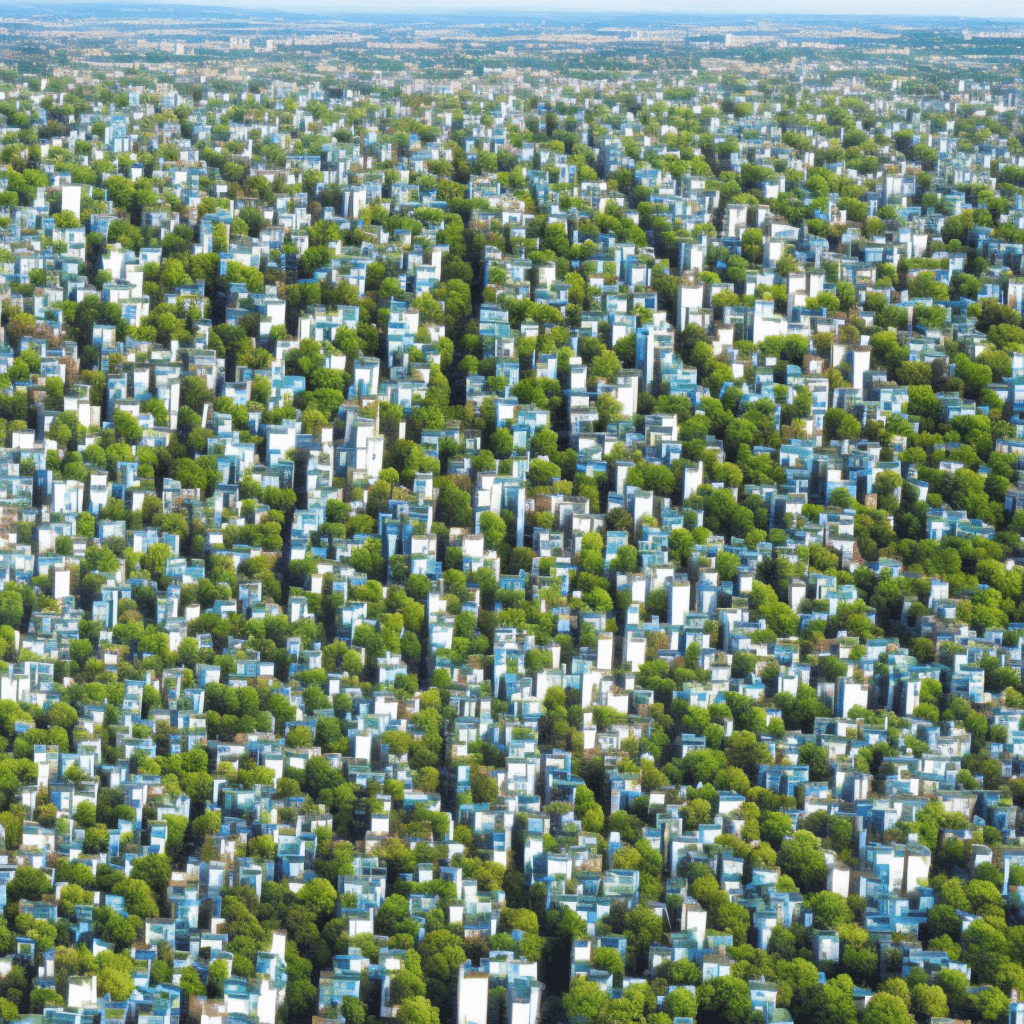How can real estate developments be designed to facilitate seamless integration with urban ecosystems for sustainable growth?

The burgeoning growth of our towns and cities, coupled with the pressing need to respond to environmental concerns, has brought the concept of urban sustainable development to the forefront. This issue revolves around the idea of designing and managing urban infrastructure in a way that promotes sustainable growth. It encompasses a range of factors, including energy management, social inclusion, green building design, and data systems management.
With the right approach, real estate developments can become a key facilitator of this seamless integration into urban ecosystems. So, how can this be achieved?
A lire également : How can real estate developments promote active lifestyles through design and amenities?
Designing Buildings with Sustainability at the Forefront
The starting point is the design process. Traditionally, buildings have been designed primarily for functionality and aesthetics. However, the increasing recognition of environmental issues has spurred a shift towards green building design.
When designing a building, the goal should be to minimize the environmental impact. This can be achieved through the use of energy-efficient materials, the incorporation of renewable energy systems, and the optimization of natural light and ventilation. The adoption of these design principles can significantly reduce the carbon footprint of buildings, contributing to the wider goal of urban sustainability.
A découvrir également : What are the emerging trends in micro-unit and compact living solutions in urban real estate markets?
Additionally, green buildings should be designed with adaptability in mind. As our understanding of environmental issues evolves, so too will our approach to building design. By designing buildings that are flexible and adaptable, we can ensure that they remain sustainable in the long term.
Implementing Energy Management Systems
Energy management is a critical aspect of sustainable urban development. It involves the efficient use of energy in buildings and infrastructure, as well as the integration of renewable energy sources.
One way to achieve this is through the implementation of energy management systems. This involves the use of data and technology to monitor and control energy use in real-time. The data collected can be used to identify areas for improvement, track progress towards energy efficiency goals, and inform decision-making.
Implementing energy management systems can not only reduce a building’s energy consumption but also contribute to the broader goal of reducing the city’s overall energy use—a critical aspect of urban sustainability.
Fostering Social Inclusion
Sustainable urban development is not just about the physical environment—it’s also about the social environment. This involves creating spaces that promote social inclusion and equality.
Public spaces play a critical role in fostering social inclusion. They are places where people can gather, interact, and participate in community activities. By designing public spaces that are accessible and inviting, real estate developments can contribute to the creation of inclusive urban environments.
Additionally, the design of residential and commercial buildings should consider the diverse needs of the community. This includes providing affordable housing options, ensuring accessibility for people with disabilities, and designing spaces that are adaptable to different uses and activities.
Leveraging Data for Sustainable Management
Data has become a powerful tool in the pursuit of sustainable urban development. It can provide valuable insights into the performance of buildings and infrastructure, inform the design and management of urban ecosystems, and support decision-making.
This involves the collection and analysis of a wide range of data—from energy use and waste generation to social demographics and economic indicators. This data can be used to identify trends, monitor progress towards sustainability goals, and inform future development decisions.
Furthermore, the widespread use of digital technologies—such as smart meters, sensors, and the Internet of Things (IoT)—has made it easier than ever to collect and analyze data in real time. This enables a more proactive and responsive approach to managing urban ecosystems.
Building Resilient Infrastructure
Finally, the quest for sustainable urban development requires the construction of resilient infrastructure. This means designing and building infrastructure that can withstand the impacts of climate change, natural disasters, and other potential disruptions.
Resilience requires us to anticipate these challenges and design our buildings and infrastructure in a way that minimizes their potential impact. This might involve designing buildings that can withstand extreme weather events, implementing robust data management systems that can respond to cyber threats, or constructing infrastructure that can accommodate changes in population dynamics.
By building resilience into our urban ecosystems, we can ensure their long-term sustainability.
In summary, the design and management of real estate developments have a critical role to play in achieving sustainable urban development. Through the incorporation of green building design principles, the implementation of energy management systems, the creation of inclusive public spaces, the use of data for sustainable management, and the construction of resilient infrastructure, real estate developments can make a significant contribution to the sustainability of our urban ecosystems.
Smart Mobility Integration and Waste Management Systems
The rapid growth of smart cities is changing the way we approach urban planning. A crucial component of smart city development is the integration of smart mobility systems, which include traffic management, smart parking, and public transport solutions. These systems are designed to reduce congestion, improve air quality, and provide more efficient transportation options, while also promoting more sustainable urban environments.
When it comes to real estate development, integrating smart mobility into the design can make a significant difference. For example, constructing buildings with ample bike storage and electric vehicle charging stations can encourage residents to choose more sustainable modes of transport. Furthermore, incorporating real-time traffic and public transport data into building management systems can help residents make informed travel decisions, contributing to a reduction in carbon emissions.
Moreover, modern real estate developments are now also focusing on effective waste management systems. A sustainable approach to waste management involves reducing, reusing, and recycling waste within developments. This can be achieved by designing buildings with dedicated recycling areas and providing facilities for composting organic waste.
Reducing energy consumption and waste production not only lowers the cost for residents, but also contributes to the wider aim of sustainable urban development. Finally, the integration of these systems with the advantages of real-time data can make a considerable impact on the quality of life for urban residents.
Green Spaces and Improving Quality of Life
Green spaces play a vital role in improving the quality of life in urban developments. They provide an aesthetic appeal, enhance air quality, promote physical activity, and offer a sense of community, all of which contribute to the overall well-being of residents.
Real estate developers have a unique opportunity to incorporate green spaces into their projects, whether through rooftop gardens, communal parks, or green walls. Such features not only provide direct benefits to residents, but also contribute to the larger ecosystem by improving air quality and providing habitats for urban wildlife.
Moreover, by integrating green spaces into developments, real estate developers can help cities achieve their sustainability goals. For instance, green roofs can reduce the urban heat island effect, lower energy consumption, and decrease stormwater runoff. These benefits collectively contribute to the resilience and long-term sustainability of urban ecosystems.
The inclusion of green spaces in real estate developments is a tangible way to enhance the quality of life for residents. When implemented thoughtfully, these spaces can foster community engagement, promote health and well-being, and contribute to the broader goals of sustainable urban development.
Conclusion
Urban development must evolve to reflect the environmental, social, and economic realities of the 21st century. As we continue to build and expand our cities, the real estate sector has a critical role to play in facilitating this transition. Through the integration of sustainable practices such as green building design, smart mobility systems, and waste management, we can create urban ecosystems that are not only vibrant and inclusive, but also resilient and sustainable.
Incorporating social inclusivity within these developments can foster a sense of community and enhance the quality of life for all residents. Leveraging the power of real-time data and digital technologies can streamline management processes and inform future sustainable practices.
By embracing sustainable real estate development, we can contribute to the creation of smart cities that are equipped to meet the challenges of the future. These practices are not merely beneficial; they are essential for the long-term sustainability of our urban ecosystems. It’s clear that the path to sustainable urban growth lies in the intersection of real estate, technology, and environmental stewardship.
